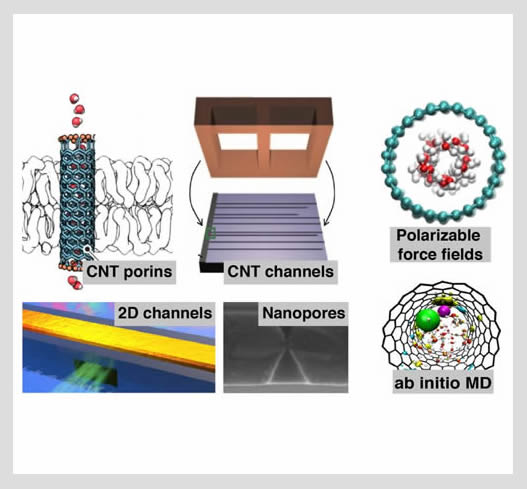Research: Thrust 1
 The effects of molecular confinement in SDNs
The effects of molecular confinement in SDNs
Strong confinement is a defining feature of these unique nanofluidic systems, and its effects permeate every aspect of the nanopore transport. Confinement forces unusual rearrangements of hydrogen bonds between water molecules in these channels, leads to formation of unusual phases, causes remarkable shifts in phase transitions and phase boundaries and amplifies the effects of defects. In addition to posing profound scientific question about the structure and motion of fluid in these unique environments, confinement effects also represent a tremendous technological opportunity, since very small nanopores are often much more efficient transporters than their macroscopic counterparts and could represent the foundations of the new generations of separation technologies.
The mission of the Thrust 1 is to deliver a comprehensive mechanistic understanding and quantitative description of enhanced flow phenomena, map phase equilibria in SDNs, and identify the mechanisms that lead to emergence of these phase equilibria. It will also explore fluid pinning at defects as well as the effect of defects on flow rate, energy barriers, and capillary filling of SDNs. Researchers who comprise Thrust 1 have developed a number of pioneering experimental systems ranging from ultra-long carbon nanotube channels and ultra-short carbon nanotube porins, to sub-10-nm 2D channels and etched ceramic and polymer nanopores. Cutting edge experimental tools, such as hyperspectral and Raman imaging, high-resolution cryo-electron microscopy, and ultrafast electron diffraction will help Thrust 1 researchers to determine the physics of transport processes in these systems. Cutting edge modeling and simulation capabilities ranging from ab-initio simulations and polarizable force field MD simulations to multiscale and continuum models support and verify the experimental efforts.
The key scientific questions that Thrust 1 will address are:
- What is the kinetics of fluid transport under confinement, what are the energy barriers for fluid transition into confinement, and how do pore-solvent and solvent-solvent interactions in confined SDNs influence those processes?
- How do the phase equilibria within confined nanopores differ from the bulk solvent, and does confinement induce unique phases and phase transitions?
- How do the structural defects in SDNs influence transport mechanism and transport efficiency?
